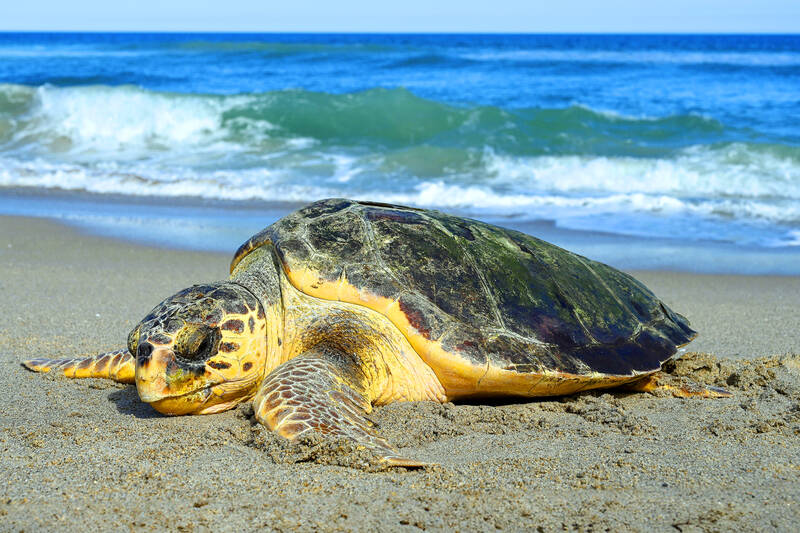Just as they have for millions of years, sea turtles by the thousands made their labored crawl from the ocean to US beaches to lay their eggs over the past several months. This year, record nesting was found in Florida and elsewhere despite growing concern about threats from climate change.
In Florida, preliminary state statistics show more than 133,840 loggerhead turtle nests, breaking a record set in 2016. Same for green turtles, where the estimate of at least 76,500 nests is well above the previous mark set in 2017.
High sea-turtle nest numbers also have been reported in South Carolina, Alabama, North Carolina and Georgia, although not all set records like Florida, where Justin Perrault, vice president of research at Loggerhead Marinelife Center in Juno Beach, said the number of nests is remarkable this year.

Photo: Loggerhead Marine Life Center via AP
“We had more nests than we had ever seen before on our local beaches,” said Perrault, whose organization monitors Palm Beach County and broke a local record by 4,000 nests. “That’s quite a bit of nesting.”
There are seven species of sea turtles: loggerhead, green, leatherback, hawksbill, Kemp’s ridley, olive ridley and flatback. All are considered either endangered or threatened. They come ashore on summer nights, digging pits in the sand and depositing dozens of eggs before covering them up and returning to the sea. Florida beaches are one of the most important hatcheries for loggerheads worldwide.
Only about one in 1,000 sea turtle hatchlings live to adulthood. They face myriad natural threats, including predators on land and in the ocean, disruptions to nests and failure to make it to the water after hatching. This year along one stretch of Florida’s Gulf Coast where 75 nests had been counted, most were wiped out by the surge from Hurricane Idalia in August.
“Unfortunately, the nests pre-Idalia were almost all lost due to the high tides and flooding on our barrier islands,” said Carly Oakley, senior turtle conservation biologist at Clearwater Marine Aquarium.
Female turtles generally lay eggs in a three-year cycle, leading to up-and-down years of nests, she said.
“The nesting process is very exhausting and, in this break, females regain the energy to do the process again,” Oakley said.
Climate change has added to those challenges, reducing beaches as sea levels rise and causing more powerful tropical storms. Hotter air, water and sand, and changes in the ocean currents turtles use to migrate also lower the odds of surviving, international conservation group Oceana said.
Sand temperatures play a major role in determining sea turtle sex. In general, warmer temperatures produce more female turtles and sand temperatures are projected to increase dramatically worldwide by 2100, researchers at Florida State University said.
“So the warmer the nest is, the more likely that nest is to produce females,” Perrault said. “Additionally, hatchlings that come out of warmer nests are much smaller and often slower.”
A study led by the academic Mariana Fuentes that was published recently in the Global Change Biology journal found sea turtles would have to nest much later or much earlier than they currently do to cope with changing environmental conditions.
Even that might not be enough for every species, said Fuentes, who works in the university’s Department of Earth, Ocean and Atmospheric Science.
Turtles have adapted to altered climates for more than millions of years, but today’s rapid changes could happen too quickly for them to evolve, she said.
“We have found that even if they do change the timing of their nesting, that’s not going to be sufficient to maintain the temperatures of current nesting grounds,” Fuentes said.
Sea turtle mothers already have to lumber out of the water to find a good spot to nest, which can be difficult in areas where humans have built seawalls. Some female turtles make several attempts, known as false crawls, before finding a suitable location.
Racoons, coyotes and other predators raid the nests and hatchlings, once they dig their way out, have to crawl to the sea before being snatched up by birds and other animals. Electric lights can disorient them, causing turtles to head the wrong way on the beach instead of following light from the moon and stars. When the lucky ones finally start swimming, hungry fish await.
South Carolina Department of Natural Resources biologist Michelle Pate said tens of thousands of hatchlings do not make it to the water, even as nest numbers trend higher across much of the Southeast.
“If we can’t get hatchlings to emerge and make it to the ocean, then an increase in nest numbers doesn’t help,” she said.
The increase in turtle nests this year conceals an ominous future for the animals, Perrault said.
“Yes, we’re seeing record numbers, but our hatchling production may not be that great,” he said. “And so in the future, 20 to 30 years from now, and these things come back to nest, we may not be seeing these record numbers that we’re seeing now.”

OPTIMISTIC: A Philippine Air Force spokeswoman said the military believed the crew were safe and were hopeful that they and the jet would be recovered A Philippine Air Force FA-50 jet and its two-person crew are missing after flying in support of ground forces fighting communist rebels in the southern Mindanao region, a military official said yesterday. Philippine Air Force spokeswoman Colonel Consuelo Castillo said the jet was flying “over land” on the way to its target area when it went missing during a “tactical night operation in support of our ground troops.” While she declined to provide mission specifics, Philippine Army spokesman Colonel Louie Dema-ala confirmed that the missing FA-50 was part of a squadron sent “to provide air support” to troops fighting communist rebels in

PROBE: Last week, Romanian prosecutors launched a criminal investigation against presidential candidate Calin Georgescu accusing him of supporting fascist groups Tens of thousands of protesters gathered in Romania’s capital on Saturday in the latest anti-government demonstration by far-right groups after a top court canceled a presidential election in the EU country last year. Protesters converged in front of the government building in Bucharest, waving Romania’s tricolor flags and chanting slogans such as “down with the government” and “thieves.” Many expressed support for Calin Georgescu, who emerged as the frontrunner in December’s canceled election, and demanded they be resumed from the second round. George Simion, the leader of the far-right Alliance for the Unity of Romanians (AUR), which organized the protest,

ECONOMIC DISTORTION? The US commerce secretary’s remarks echoed Elon Musk’s arguments that spending by the government does not create value for the economy US Secretary of Commerce Howard Lutnick on Sunday said that government spending could be separated from GDP reports, in response to questions about whether the spending cuts pushed by Elon Musk’s Department of Government Efficiency could possibly cause an economic downturn. “You know that governments historically have messed with GDP,” Lutnick said on Fox News Channel’s Sunday Morning Futures. “They count government spending as part of GDP. So I’m going to separate those two and make it transparent.” Doing so could potentially complicate or distort a fundamental measure of the US economy’s health. Government spending is traditionally included in the GDP because

Hundreds of people in rainbow colors gathered on Saturday in South Africa’s tourist magnet Cape Town to honor the world’s first openly gay imam, who was killed last month. Muhsin Hendricks, who ran a mosque for marginalized Muslims, was shot dead last month near the southern city of Gqeberha. “I was heartbroken. I think it’s sad especially how far we’ve come, considering how progressive South Africa has been,” attendee Keisha Jensen said. Led by motorcycle riders, the mostly young crowd walked through the streets of the coastal city, some waving placards emblazoned with Hendricks’s image and reading: “#JUSTICEFORMUHSIN.” No arrest